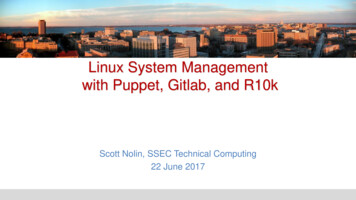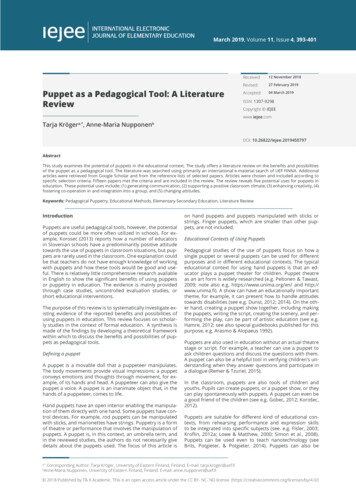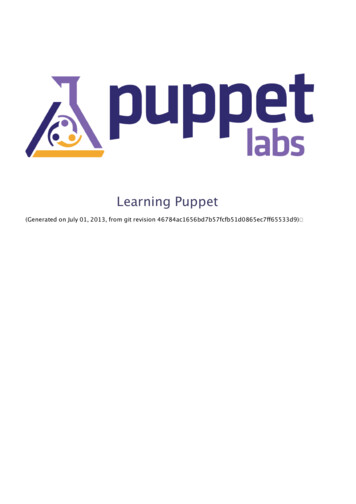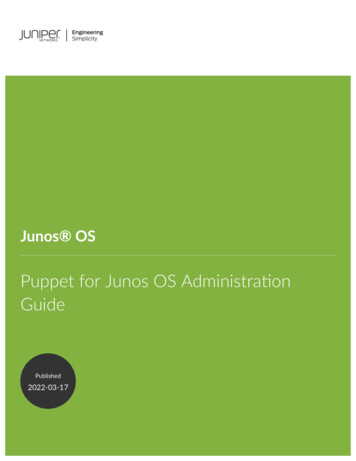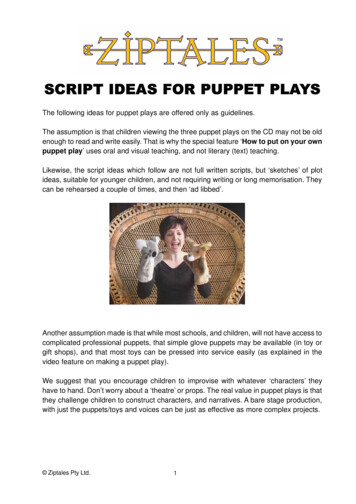
Transcription
Puppet, Gitlab, and R10kAt the Space Science and Engineering CenterScott Nolin, SSEC Technical Computing10/31/2016
IntroductionI am here to talk about how we do linux configuration management at SSEC. I am doingthis to encourage others doing similar work so we can ideally share ideas and learn fromeach other. This is a topic that is important and useful for UW IT in general, and sharinginformation we can help each other.
About SSEC and Technical Computing (TC)
The Space Science and Engineering Center at the Universityof Wisconsin MadisonA research and development center focusing on geophysical research and technology toenhance our understanding of the atmosphere of Earth, the other planets in our SolarSystem, and the cosmos.Major SSEC Initiatives atmospheric studies of Earth and other planets interactive computing, data access, and image processing spaceflight hardware development and fabrication
The SSEC Mission and Structure Shape TechnicalComputingMission Satellite meteorology requires high performance computing and large data. The ratio ofcomputing to data is weighted towards data.Structure SSEC is a matrix organization – teams of people from various units work together on multipleprojects. Multiple simultaneous projects means often varying requirements for computing. SSECcomputing must be responsive to this, we must be able to change, adapt, and provide projectneeds rapidly.
The Technical Computing Group (TC)Support all computing at SSEC Uniquely responsible for helping center as a whole Routine operations Security Research computingSix Full Time staff 2 Windows/Mac admins – more traditional IT infrastructure 3 Linux - Science integration, instrumentation, and HPC focused 1 – Head of TCUp to Six Students Assist with helpdesk
SSEC Computing Footprint100 macs – mostly laptops135 Windows (8 virtual) – mostly desktops and laptops755 Linux (50 virtual, 705 physical) – supporting research mission 259 cluster nodes 170 HPC Storage servers, about 12PB of storage250 staff users, 50 student staff, 150 collaborators
Configuration Management, Version Control
Why We need Linux configuration managementThe center’s mission and structure means there are many systems, and many groupswith different needs running systems. Linux systems are the core of our researchsystems. Ensure consistency and repeatability Faster time from install to production Adapt to change quickly Lower labor costs Computer Security Applying computer policy consistentlyAuditing
Why Version Control Version control of configurations reduces fear and increases accountability. See Dave Plonka’s ‘Sysadmin File Revision Control with RCS’ from 1998 We had done this for many years with CVS, SVN, and now git and some of our configurations. DNS zone files Monitoring server configuration (check mk/omd) Version control was the ‘end’ of for example a script updating zone files or the check mkconfiguration. We saved configurations we applied to config managment. With Puppet, you manage ‘everything’, so configuration management is even more important. We move version control to the forefront. We start with version control and end with changes inpuppet. Version control is how we trigger a configuration change, not how we store a change we made.
The SSEC System
Puppet History at SSEC2011, Initial: Puppet server for testing and light use Used to distribute science software rpms/lmod modules, yum repositories, and monitoring client checksEdit modules directly on serverAssign modules to hosts in server configuration filesNo integrated version control (ad-hoc for some modules)February 2015, Configuration as Code: Puppet, Gitlab, gitlab hooks, and puppet-sync Version Controlled pdxcat/puppet-sync Pre-receive hooks for tests, Post-receive hooks for puppet-sync branches are environments Git workflow accelerated development of modules Used for ‘everything’, new stuff and converting existing. Problem with git client and gitlab gui and hooks - tests were in pre-receive, never get triggered in GUI Monolithic gitlab repository bad for sharing with other groupsJuly 2016, Gitlab-CI method: Puppet, Gitlab, Gitlab-CI, and R10k The gitlab GUI is a first class citizen CI/CD methods are generally well understood and accepted Gitlab-CI provides a gui, making it easier to visualize and maintain your production pipeline.
SSEC Workflow: Routine Administration Node Classification – we use Foreman as External Node Classifier, there are otheroptions Assign nodes to environments, such as a test environmentAssign modules (puppet classes) to nodesSimple data changes for hosts or groups of hosts are done in master branch of controlrepository. Gitlab GUI or git cli tools. User operations: add local users, override attributes (example: modify UID if needed), Allowaccess to a machine for a domain user.Manage public keysSudoers
SSEC Workflow: Bigger Changes1. Create short lived branches, for example “scott test”2. Assign test nodes to scott test environment3. Test changes4. Merge test branches to master5. Move test nodes back to master
Long Lived Branch WorkflowOur short lived branch workflow is only one way to do this. Another idea is to have a longlived test branch. Force all changes to go to the test branch and merge to master (or ‘production’) afterpassing Have some hosts permanently assigned to the test environment This can be a highly structured workflow with checks and balances. Only some adminscould be allowed rights to merge for example. These methods can be combined. Permanent testing VM’s for a long lived branch, butstill doing the short-lived branch test methods is a direction we may go at SSEC. Iespecially like the idea of some nightly complete system rebuild testing.
Where did I get the idea for puppet/r10k/gitlab?This is based on first looking at Phil Zimmerman’s‘An Automated R10K Workflow That Works’ and attempting to replicate -workflow-that-works/This uses R10kGithub ub.com/pzim/reaktorAs I was wrestling with various components gitlab-ci developed rapidly and showed great promise.It worked.
SSEC System Components Puppet – configuration management serverGitlab– git server, with integrated Continuous Integration features (CI). Foreman – Puppet GUI and node classifier Includes gitlab-ciCI Scripts you write do the work: bash, perl, python, whatever you wantoptional, but niceR10K Code management tool that maps Git branches to Puppet environments.Make a branch called ‘testing’ in git, and an puppet environment called ‘testing’ is created.Assign test machines to testing branch and test.
Aside: Puppet Enterprise Code ManagerPuppet enterprise now includes Puppet Code Manager, a tool that manages r10k for you.Our method uses gitlab-ci scripts.Code Manager is Enterprise only.One technical difference that may be important to some is it pauses the puppet serverduring updates to avoid conflicts.
R10K: Control Repository and PuppetfileThe control repository controls the puppet environments, it is a critical component. The controlrepository contains the Puppetfile and more.The puppetfile is a file listing all other repositories with modules you use. These can be anycombination of your own git or puppet forge, your own private, or someone else’s. For security we use adedicated gitlab server, and download, curate and re-host any repositories we use from outside.Consider that you likely would not share your control repository with others, but may share othermodules, which are building blocks.#Puppetfile example#Here are some Puppet Modules. These reference our git server, but#could be any git or puppet forgemod 'ipmi',:git 'git@sgit.ssec.wisc.edu:tc-puppet/ipmi.git',:ref 'master'mod 'winbind',:git f 'master'mod 'augeasproviders core',:git 'git@sgit.ssec.wisc.edu:tc-puppet/augeasproviders core.git',:ref 'master'mod 'zpool scrub',:git 'git@sgit.ssec.wisc.edu:tc-puppet/zpool scrub.git',:ref 'master'
R10K: Control Repository ContentsAnything that is routinely changed will be more convenient to be in control than anexternal repository. You could have a mostly empty puppetfile and put most puppetmodules in control, mimicking the monolithic puppet-sync method. hieradata – this can be it’s own module, but for SSEC, is changed frequently. Forexample, it’s how we allow users login to linux systems. So we put it in control. site/ modulename – we put the ‘site’ directory is in the modulepath, so this addsmodules in the control repo directly You can put any modules you want in site/We use - site/profiles, site/role, and site/hostgroups. Notice these are generally ‘sitespecific’ things for SSEC, likely would not be shared. They’re how we compose things,using other basic building block modules from outside control repo, as defined in thePuppetfile.
Gitlab CIGitlab CI is an integrated CI/CD system that comes with gitlab for testing, building, anddeploying code Continuous Integration (CI) is a development practice where you integrate code for aproject frequently. Check-ins are tested via an automatic build process. Continuous Deployment (CD) is similar, focused on delivery of software to the end user.In our use case, we test our puppet modules, and deploy them to the puppet server. Weuse Gitlab-CI and R10K instead of our previous git server-side hooks and pdxcat/puppetsync.
Push to GitlabProcess FlowIs code valid(passes tests)?NoYes (Control Repo)Is this controlrepository?No (Is Module)Is code valid(passes tests)?YesYesHas PuppetfileChanged?Does controlhave a matchingbranch?NoYesYesR10K deployenvironment and allmodulesNoGet controlrepo andPuppetfileR10K deployenvironment onlyYesIs module inPuppetfile?YesReport ErrorReport ErrorR10K deploy moduleEnd
Data FlowCodeGitlab ServerPuppet ServerPuppetModuleGit RepoGitlab CIGitlab CIConfigurationR10KPuppetControlGit RepoGitlab Runner ServerTestDeployPuppet configfiles
Authentication Between Components Gitlab deploy keys – allow read-only access to a gitlab repository R10K user @ puppet server’s ssh public key is used as gitlab deploy key on control and allmodule repos. This is how r10k@puppet server grabs the repositories from gitlab. Gitlab-runner user @ runner server’s ssh public key is used as gitlab deploy key on the controlrepository only. The runner uses this to get the puppetfile for tests. Normal system SSH keys Gitlab-runner@runner server ssh public key is added to r10k@puppet server authorizedkeys. This is how the gitlab runner can ssh to the puppet server to run r10k commands. We manage public keys with puppet, adding them to authorized keys. Of course there’s thebootstrap issue for these in particular. Maybe a diagram will help?
AuthenticationCodeGitlab ServerPuppet ServerPuppetModuleGit RepoGitlab CIGitlab CIPuppetControlGit RepoConfigurationControl and all module reposGitlab deploy key R10k@puppetserver pubkeyR10KPuppet configfilesControl repo Gitlab deploy key gitlab-runner@runner server pubkeyGitlab Runner ServerTestGitlab-ci process handles authDeploygitlab-runner@runner server pubkeyin r10k authorized keys
Gitlab CI: Control RepositoryAdding .gitlab-ci.yml file to the repo defines the processstages:- test- r10kpuppet test:stage: testscript: puppet testallow failure: falsehiera test:stage: testscript: hiera testallow failure: falser10kdeploy:stage: r10kscript: r10k control deployallow failure: falseScripts are run on the gitlab-runner linux host.There are docker and shell runner methods, weuse shell, but either will work.The gitlab-runner user simply executes whateverscript you give it in it’s shell.This naturally has security concerns, the gitlabrunner needs to be treated as securely as allother system components. If compromised, allyour hosts are compromised easily.
Gitlab CI: All Other ModulesAdding .gitlab-ci.yml file to the repo defines the process for modulesstages:- test- r10kdeploy- foremanpuppet test:stage: testscript: puppet testallow failure: falser10K modtest:stage: testscript: r10k modtestallow failure: falser10k moddeploy:stage: r10kdeployscript: r10k moddeployallow failure: falseOur general puppet tests are the same, andnotice we don’t test hieradata – that lives incontrol only.We do module specific tests and deployment.
Gitlab CI Script Details The following slides examine parts of the gitlab-ci scripts that may help explain theprocesses I think are critical. I will share complete scripts if you would like, just let meknow. We can also go back and discuss the overall process more at this point, as the followingslides are details.
CI Scripts: Control Modules
r10k control deploy#!/usr/bin/perluse strict;use warnings;my PREFIX "tc";my BRANCH " ENV{CI BUILD REF NAME}"; #branch namemy r10k env " {PREFIX} {BRANCH}";my NEW MODULE 0;my NEW MODBRANCH 0;my NEW ENV 0;my PUPPETSERVER “myserver.com";my exit val;#debugging and info subroutine removed for brevity#deploy the branchif ( puppetfile changed) {print "DEPLOY ENVIRONMENT AND MODULES:\n";system ("ssh r10k\@ {PUPPETSERVER} r10k deployenvironment r10k env --puppetfile --verbose"); exit val ? 8;if ( exit val ! 0) {die("failed to: ssh r10k\@ {PUPPETSERVER} r10kdeploy environment r10k env --puppetfile --verbose\n");}} else {print "DEPLOY ENVIRONMENT ONLY:\n";system ("ssh r10k\@ {PUPPETSERVER} r10k deployenvironment r10k env --verbose"); exit val ? 8;if ( exit val ! 0) {die("failed to: ssh r10k\@ {PUPPETSERVER} r10kdeploy environment r10k env --verbose\n");}}If you find my scripts depressing,make better versions and shareplease!#get changed filesmy puppetfile changed 0;my @changedfiles git diff --name-status HEAD ordie("FAILED: git diff --name-status HEAD \n");foreach my line (@changedfiles) {chomp line;print " line\n";my @linearray split(' ', line);if ( linearray[1] eq 'Puppetfile') { puppetfile changed 1;}}
r10k control deploy#!/usr/bin/perluse strict;use warnings;my PREFIX "tc";my BRANCH " ENV{CI BUILD REF NAME}"; #branch namemy r10k env " {PREFIX} {BRANCH}";my NEW MODULE 0;my NEW MODBRANCH 0;my NEW ENV 0;my PUPPETSERVER “myserver.com";my exit val;#debugging and info subroutine removed for brevity#get changed filesmy puppetfile changed 0;my @changedfiles git diff --name-status HEAD ordie("FAILED: git diff --name-status HEAD \n");foreach my line (@changedfiles) {chomp line;print " line\n";my @linearray split(' ', line);if ( linearray[1] eq 'Puppetfile') { puppetfile changed 1;}}#deploy the branchif ( puppetfile changed) {print "DEPLOY ENVIRONMENT AND MODULES:\n";system ("ssh r10k\@ {PUPPETSERVER} r10k deployenvironment r10k env --puppetfile --verbose"); exit val ? 8;if ( exit val ! 0) {die("failed to: ssh r10k\@ {PUPPETSERVER} r10kdeploy environment r10k env --puppetfile --verbose\n");}} else {print "DEPLOY ENVIRONMENT ONLY:\n";system ("ssh r10k\@ {PUPPETSERVER} r10k deployenvironment r10k env --verbose"); exit val ? 8;if ( exit val ! 0) {die("failed to: ssh r10k\@ {PUPPETSERVER} r10kdeploy environment r10k env --verbose\n");}}
Clicking the CI Step shows the output.In this case I modified r10k control deploy itself.I found a bug while making these slides.
What happened? Gitlab-ci ssh’ed to the puppet server andran r10k deploy.print "DEPLOY ENVIRONMENT ONLY:\n";system ("ssh r10k\@ {PUPPETSERVER} r10k deploy environment r10k env --verbose");
Clicking the commit shows the diff
CI Scripts: Other Modules (not control)
r10k modtest: check for matching control branchmymymymymy BUILD TMP "/home/gitlab-runner/tmp/ ENV{CI BUILD ID}"; PUPPETFILE " {BUILD TMP}/Puppetfile"; GITBASE 'git@sgit.ssec.wisc.edu:tc-puppet'; CONTROLREPO " {GITBASE}/control.git"; BRANCH " ENV{CI BUILD REF NAME}"; #branch namemy heads git ls-remote --heads CONTROLREPO BRANCH ;my exit val ? 8;#system returns 0 on success, shift 8 bitsif ( exit val ! 0) {cleanup die("Failed to\n git ls-remote --heads CONTROLREPO ENV{CI BUILD REF NAME}\n\n");}print " heads\n";my @head array split ('/', heads);chomp @head array;if (exists head array[2]) {if ( head array[2] eq BRANCH ) { CONTROL BRANCH EXISTS "true";}}R10k modtest is too large for a slide.Complete scripts are available, seeaddenda.If you make a branch called “test” on the“foo” repository, control should have amatching “test” branch.So gitlab-runner user needs permission toread the control repo to see if the branchexits.Our process simply fails if it does not exist.Branching control is manual. Our dailywork is all in ‘control’ typically, so thisdoesn’t happen often. Junior admins workentirely in control repository.
r10k modtest: checking against puppetfile#PUPPETFILE - Puppet Modulesmod 'ipmi',:git 'git@sgit.ssec.wisc.edu:tc-puppet/ipmi.git',:ref 'master'mod 'winbind',:git f 'master'mod 'augeasproviders core',:git 'git@sgit.ssec.wisc.edu:tc-puppet/augeasproviders core.git',:ref 'master'mod 'zpool scrub',:git 'git@sgit.ssec.wisc.edu:tc-puppet/zpool scrub.git',:ref 'master'Gitlab-runner is working with the module “other” remember?The puppetfile is in control repo, and should containreferences to this other module. So the gitlab runner usermust be trusted to do a git clone of control.For example “impi” is shown in our example puppetfile.We then parse puppetfile for the expected entries, and fail ifthey are missing as we did with our branch check.
r10k modtest: checking against puppetfilesystem ("git clone -b {BRANCH} --single-branch {CONTROLREPO} {BUILD TMP}"); exit val ? 8;if ( exit val ! 0) {cleanup die("failed to:\n git clone -b {BRANCH} --single-branch {CONTROLREPO} {BUILD TMP}\n\n");}#parse puppetfile# - we read theopen my fh, PUPPETFILE or cleanup die("Failed to open PUPPETFILE\n");chomp(my @lines fh );close fh;.(etc)Here’s just the bit where we clone thecontrol repository.
r10k moddeploy#!/usr/bin/perluse strict;use warnings;mymymymymy PREFIX "tc"; BRANCH " ENV{CI BUILD REF NAME}"; #branch name r10k env " {PREFIX} {BRANCH}"; PUPPETSERVER "foreman.ssec.wisc.edu"; exit val;#NOTE MOD SHORT - we are assuming the module name is alwaysembedded# in the repo name as the last path entry# example puppet/szip.git# 'szip'#my @THISREPO split ('/', ENV{CI BUILD REPO});my MOD SHORT pop @THISREPO; MOD SHORT s/\.git//g;print "DEPLOY\n";system ("ssh r10k\@ {PUPPETSERVER} r10k deploy module -e r10k env MOD SHORT --verbose"); exit val ? 8;if ( exit val ! 0) {die("failed to: ssh r10k\@ {PUPPETSERVER} r10k deploy module e r10k env MOD SHORT --verbose\n");}
Discussion
Oct 31, 2016 · February 2015, Configuration as Code: Puppet, Gitlab, gitlab hooks, and puppet-sync Version Controlled pdxcat/puppet-sync Pre-receive hooks for tests, Post-receive hooks for puppet-sync branches are environments Git workflow accelerated development of modules
